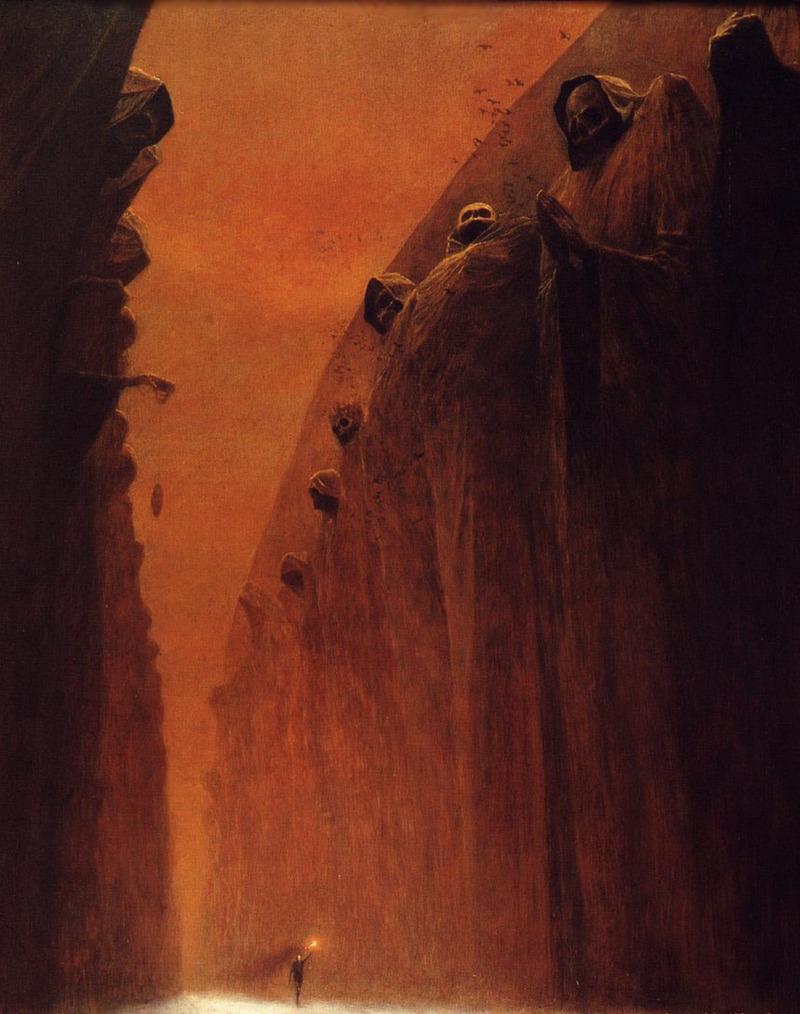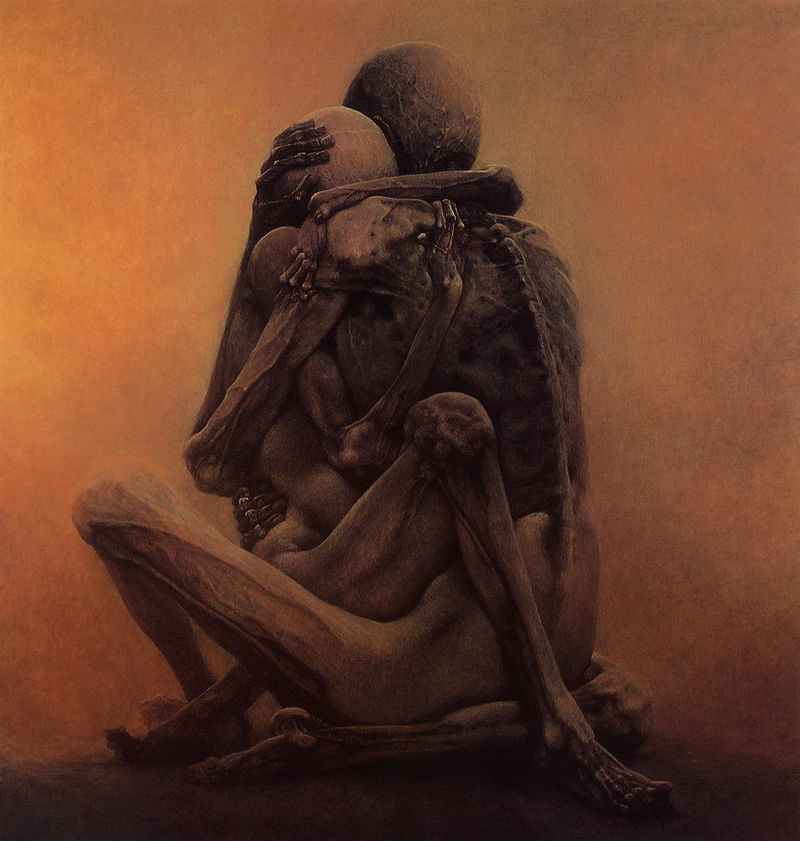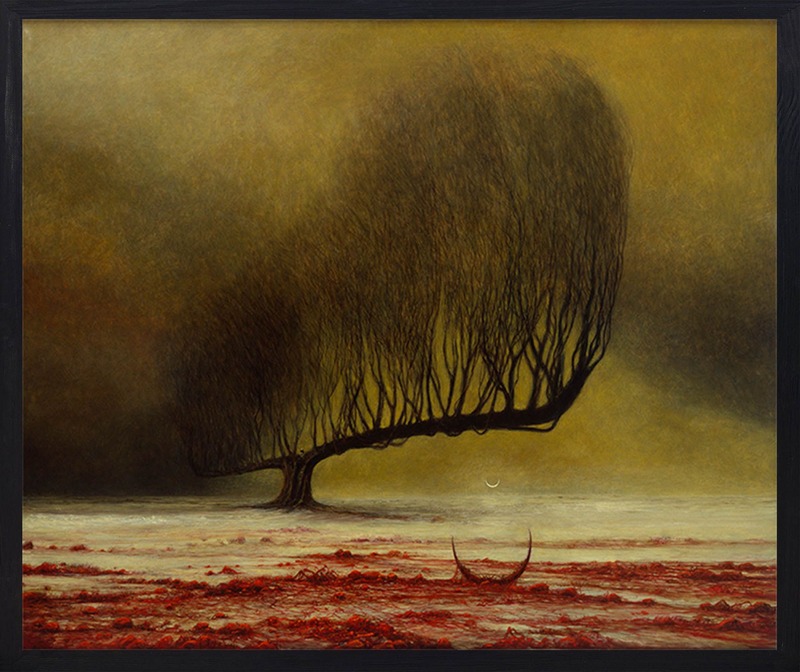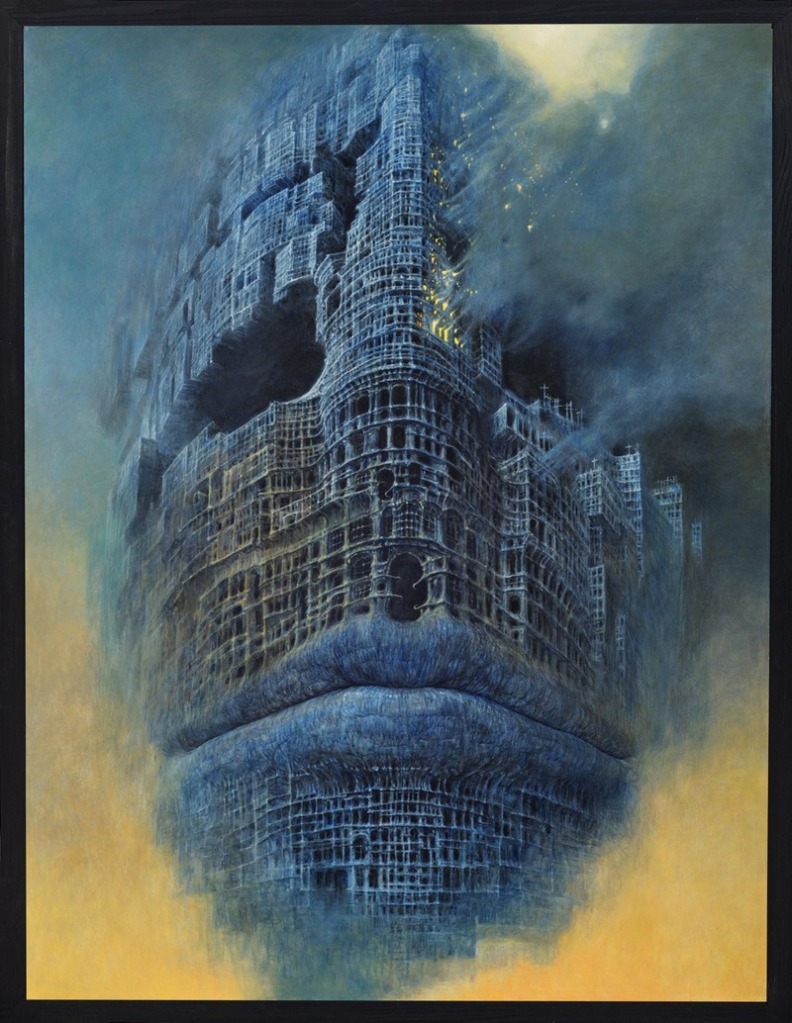
[Zdzislaw Beksiński, oil on panel, not exhibited]
Last week I visited the Museum of the Archdiocese of Warsaw (www.maw.art.pl), which has a varied and interesting collection of art, antiques, liturgical regalia and church-related archive material. This is a review of only two temporary exhibitions at the museum.
Beksiński from the Anny and Piotra Dmochowskich Collection (June 2021-June 2024) is the group of notable paintings by Zdzislaw Beksiński (1929-2005) paintings, owned by his French dealers. The paintings range from 1970 to the year before the artist’s murder, which was a senseless impulsive killing of an elderly man over a trivial sum. It is hard to detach appreciation of Beksiński’s paintings with the difficult life of the painter. The death of the artist’s wife, the suicide of the artist’s son and the trauma of war, economic decline and social turmoil, which spanned Beksiński’s adult life – as well as his violent death – all seem in congruence with his images of suffering, desolation and entropy. Crucifixes abound, as do mummified personages, bandaged figures. Bones of strange creatures litter misty plains, tendrils of crimson vegetation expand like bloody stains, as powerful winds shred cloths as large as buildings. Bodies exist but we have no inkling of their existence outside of the singular images. Do they have language? What do they eat and how do they reproduce? Are they in pain? Is what we see normal in their world? Who built the strange structures that fill the vistas? So alien are these personages that we cannot map on to them motivation or even agency.
Beksiński loved to describe surfaces in intricate detail, especially the vegetable, textile and petrological. The flatness of figures in the 1990s is an affinity with the immediate post-war style of Modernists, found in Poland and elsewhere. Lighting effects can be somewhat cursory and the ubiquitous smoke/cloud/mist effects are an easy way of concentrating attention on to motifs, which are the sole objects within some paintings. With Magritte, we get the mundane made magical; with Beksiński, we get the macabre made real. The fantastic has wrinkles, texture and discoloration.
Beksiński trained in architecture and the interface between buildings, plants and bodies are a staple of the paintings; they are in some ways close to his contemporary H.R. Giger, best known for his visual conceptualisation of the creatures and environments of the original Alien movie (1979). Beksiński is drawn to the monumental, with the inclusion of tiny figures or trees that turn the central personage into a giant or a structure into a colossal edifice, tall as a mountain. These are scenes that defy reason and explanation, which adds to their cheerless quality, although we may be thrilled at the sublime spectacle of strangeness and massiveness.

[Zdzislaw Beksiński, oil on panel, 1985, 100 x 98 cm, exhibited]
When intimacy appears in Beksiński’s oeuvre, it is of a particularly poignant sort. A 1984 painting here shows two humanoids embracing; they are gnarled, naked and vulnerable, finding solace in one another. We cannot help but think of them as outcasts, using our own bodies as references points. A point of comparison might be the graphic art of Hans Bellmer, whose art featured figures with rearranged anatomies engaging in sexual congress. We do best to class Beksiński as a latter-day Surrealist, as his art involves the incongruous, the fantastic, the sexual and impossible; it is troubling and opens up to us alternative worlds, drawing out unobvious connections. Connections between Beksiński and Bellmer are numerous, ones I would like to discuss at length in future.

[Zdzislaw Beksiński, oil on panel, 1984, 100 x 97 cm, exhibited]
Beksiński’s fantastic faces with deformities or odd combinations are generally the weakest of his art; they seem five-finger exercises in variant making, with relatively little thought given to the impression of the finished painting. What are his weaknesses? Cheap sensationalism, reversion to the familiar, the tendency to obscure as a way as avoiding problem solving, a jejune proclivity to provoke. There is entropy and decay but little we can see that could be called action or dynamic energy. However, the better qualities of his art – its emotional force, inventiveness, memorability, originality, consistency of worldview, congruence of technique, image and mood – surpass those failings.

[Zdzislaw Beksiński, oil on panel, 1979, 73 x 87 cm, exhibited]
These 27 paintings are all oil on board, mainly rectangular, roughly 80 x 60 cm to 130 x 100 cm. The surfaces are quite smooth, in contrast with Beksiński’s early paintings, which were standard Modernist painterly pictures with sgraffito. The surfaces are not inert, as image-driven (rather than material-driven) art often is, with a pleasing attention to the qualities of paint – smooth but not slick. His palette is effectively varied, with earth and cold hues predominating. It is never lively or pretty. Beksiński’s art lacking all humour or wit, but that comes with a refreshing earnestness and absence of irony.
The paintings are accompanied by an exhibition of photographs, taken by Beksiński early in his career, mainly in the 1950s and 1960s (9 March-11 June 2023). These range from the quirky to bleak. There are portraits, some using special effects and montage, some head shots set against large areas on blank space. There are some female nude torsos and some images of industrial entropy, such a mangled chain-link fence. It is not difficult to discern continuation of themes, images and mood from these photographs in the later paintings. I do not know photography well enough to state whether these examples are very distinguished but they do seem typical of mid-century avant-garde photography and reference points for Beksiński’s visual thinking and preferences.
Beksiński was relatively reclusive and did not travel much. Much of his work was sold via his Paris gallery. None of the paintings have titles and Beksiński was reluctant to discuss the interpretation of his art and here we encounter a fault line in the reception. Art critics are wary about discussing what they call art that is not truly fine art because it is too popular, too involved with traditional technique, too close to genre culture in terms of imagery (and fanbase). The interiority of Beksiński’s world – and the very fact it does seem a world – places Beksiński outside the arena of fine art. There are a number a reasons why Bosch is taken seriously but Beksiński is not. One is simply time; Beksiński is simply too close to us to have artistic weight. Another reason is that Bosch’s visions are connected to an obscure aspect of Christian theology, whereas Beksiński’s cosmology (if he has one) is private and unarticulated, without the sanction of religion or spirituality. Also, it has to be said that Beksiński’s art is limited by its lack of potential redemption, joy and emotional range.
This is the first time I have seen Beksiński’s paintings or photographs face to face, despite him being a well-known and influential contemporary artist for decades. You would not encounter this art in any ACE-funded venue in Great Britain. The tyranny of good taste keeps from us art that has been pigeonholed as popular and genre. That might be unremarkable where you had thriving independent venues that bucked such standards and was willing to explore art not approved by the curatorial class, but in our country there is little independence, outside of some commercial galleries and a handful of co-operative spaces. Yet, viewed in its own terms, why should Beksiński be beyond the pale? I take Glenn Brown to be one of the best of living painters and there are more than a few parallels between his painting and that of Beksiński: the technical accomplishment, faultless technique, a preference for smooth grounds, a use of indeterminate pictorial depth, lack of ironic distance, a taste for the bizarre. Is it so gauche to compare the pair? Personally, I would rather spend an hour with Brown or Beksiński’s paintings than with that by any of the Turner Prize nominees of the last decade.

[Zdzislaw Beksiński, oil on panel, not exhibited]
Why should a conceptual stunt be any more highly regarded than the powerful images and strange worlds of Beksiński? Accepting the seriousness of Beksiński and H.R. Giger does not mean accepting Beryl Cook and Jack Vettriano. We should not automatically accord to the painter of fear and bleakness a greater degree of respect than that to a satirical, decorative or comfort-producing painter, that would be just another form of unthinking snobbery. We should not shy away from being discriminating and from shunning and ridiculing art that we find execrable, but only acting like so once we have thought through our objections. It is commonly assumed that we act on emotion and deep affinity and that we rationalise our taste only post hoc with intellectual explanations. That may be so, but such discussion at least helps us (and others) to comprehend what might be our values and taste, even if we come to such understanding in a veiled indirect manner.
Is Beksiński taken less seriously as an artist because he is classed as a horror or sci-fi artist than a fine artist? Does his lack of formal training – especially when coupled with his masterful technique – irk mainstream critics? Doubtless the advent of the internet was both the best and worst thing that happened to the reception of Beksiński’s work. It allowed his imagery to circulate widely and led to recognition, but it also spawned a host of inferior imitators, most amateur (all distributing their work on social-media and art-sharing website) which led to fatigue with Beksiński-type imagery.
It seems that not only snobbery but the self-consciousness of critics that prevents us from expanding our definitions of fine art to encompass the popular painter. “Fine Art” is now in the hands of administrators who loath technical accomplishments and consider aesthetics an imaginary game played by connoisseurs. Why not look to image makers of distinction now that State Art has adopted Amnesiac Art as its vehicle for soft diplomatic power (abroad) and demoralisation of the population (domestically)? We are despised by this cadre. We have nothing to lose in throwing off the shackles of “good taste” of those apparatchiks, if compliance means denying the better part of what art is capable, namely, its capacity to transport us emotionally, the aspiration towards beauty, the development of craftsmanship, the value of the canon, the primacy of the art not the artist (and his skin colour). All these things delighted our forebears and draw derisive coldness from apparatchiks. Keeping the self-conscious, conspicuously educated art-appreciators corralled in this zone of Fine Art (one subject to constant adjustment) is a way of preventing them from forming their own taste, expressing their values, rejecting arbitrary administrative authority and laughing at what appears in State Art venues.
We art lovers are now unpersons; it is time we took up the freedom of the unperson, that is, to have our own standards and be unafraid to express them. After all, who among us will be invited to teach at university, helm a civic museum, advise a government body or become a director of the Arts Council? Why should we care what such officials think about our views? Shouldn’t we want to distance ourselves as much as possible from those gimlet-eyed fanatics and thoughtless drones? Refusing to become independent even after the ritual humiliation of our craft and tradition is the sign of a broken hopeless people. Against all evidence, I hope we are not at that debased level.
To read more of my thoughts on Beksinski follow this link to my Substack channel: https://alexanderadamsart.substack.com/p/the-art-of-beksinski-and-the-tragic
